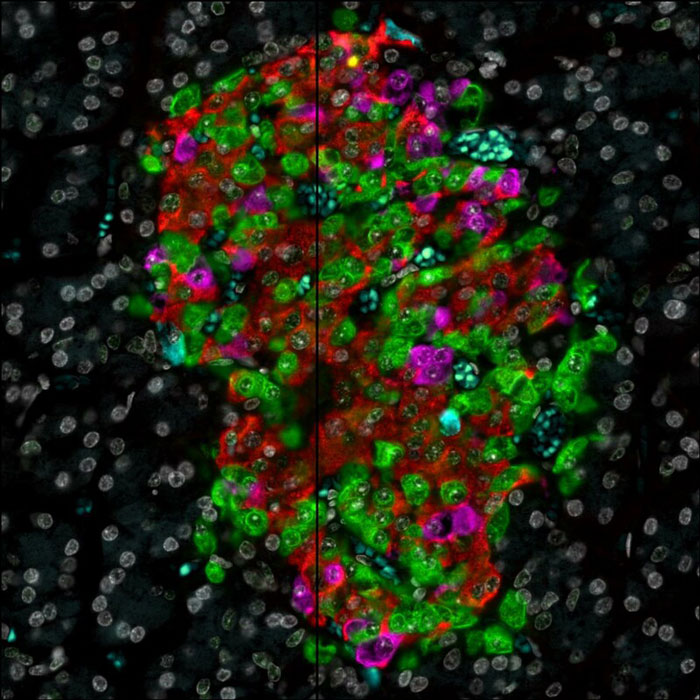Home > About JDRF & our impact > Our research > Prevention research >
Screening for type 1 diabetes
Screening aims to find people in the earliest stages of developing type 1 diabetes.How can I get screened for type 1 diabetes?
In the UK we don’t have a national population screening programme for type 1 diabetes. There are several research projects taking place across the UK to investigate how best to screen the UK population for type 1 diabetes so that we can integrate it into our healthcare system.
Depending on your age and connection to type 1, you may be able to get screened as part of one of these research projects.
UK population screening for type 1 diabetes
The ELSA Study is screening 20,000 children aged 3-13 in England and Wales for type 1 diabetes. Find out more about the ELSA Study and sign up to receive your blood test kit.
The Type 1 Diabetes Risk in Adults (T1DRA) Study is testing blood samples from adults aged 18-70 in the UK to assess their risk of developing type 1 diabetes.
Screening family members for type 1 diabetes
A project called INNODIA, which we co-fund, screens people aged 1 – 45 who are at increased risk of type 1. This is either because they have a close family member with type 1 (which includes brothers, sisters, parents or children) or another screening programme, such as the ELSA Study, has detected that they are at increased risk of type 1. INNODIA screens people by analysing their blood, urine and stool samples.
Why do we need to screen people for type 1?
A quarter of children are diagnosed in diabetic ketoacidosis (DKA), which is a potentially fatal condition resulting from late diagnosis. People who have experienced DKA are likely to have worse health outcomes such as an increased risk of diabetes-related complications. Identifying people in the earliest stages of developing type 1 reduces the risk of DKA because it makes people aware of the signs and symptoms of type 1 diabetes.
Screening is also crucial to ensure our prevention research reaches those who can benefit from it most. For example, the immune therapy teplizumab can delay the progression from stage two to stage three type 1 diabetes by roughly three years. But we need screening in place to know who those people in stage two are.
Read our blog with Dr Rachel Besser on the benefits of screening for type 1.
What are the stages of type 1 diabetes?
We now understand that people start developing type 1 diabetes long before they start needing to take insulin. We can now split type 1 diabetes into three progressive stages.
 Stage three is when people present with symptoms of type 1 diabetes and are diagnosed with ‘clinical’ type 1 diabetes. This means there are two stages before diagnosis where the immune system’s attack on insulin-producing beta cells has begun. These two stages are known as early stage or pre-symptomatic type 1 diabetes.
Stage three is when people present with symptoms of type 1 diabetes and are diagnosed with ‘clinical’ type 1 diabetes. This means there are two stages before diagnosis where the immune system’s attack on insulin-producing beta cells has begun. These two stages are known as early stage or pre-symptomatic type 1 diabetes.
In stage one type 1 diabetes, the immune system has already developed cells called autoantibodies which attack and destroy the insulin-producing beta cells. People in this stage don’t experience any symptoms and their blood glucose levels are stable. Once people move into stage two, their blood glucose levels begin to fluctuate but they still don’t experience any symptoms. Screening programmes attempt to find people in stage one and two of type 1 diabetes.
How can you screen for type 1 diabetes?
Screening tests for type 1 diabetes look for clues that someone is at high risk of developing type 1. The test can include genetic tests as well as samples of blood, urine or poo.
We are funding Professor Richard Oram to develop a combined risk calculator for type 1 diabetes. His algorithm combines several different factors such as genetics, family history, and protein markers (autoantibodies) of type 1 diabetes to give individuals a percentage risk of them developing type 1 in the next one, three, and five years.
How do our genetics affect our risk of type 1?
There are over 50 genes which put you at higher risk of type 1 diabetes. Because we inherit our genes from our parents, people with a close family member with type 1 are more likely to develop type 1.
But most people with close relatives who have type 1 still won’t develop it themselves as most people with type 1 don’t have a family history of the condition. So, testing for these 50 genes doesn’t conclusively tell us who will get type 1, only who may be at risk.
What are autoantibodies?
Autoantibodies are immune cells that attack our own cells instead of invaders like viruses and bacteria. Different autoantibodies attack different types of cells, but usually our immune systems are good at destroying them before they cause damage. In type 1 diabetes, autoantibodies attack and destroy the insulin-producing beta cells in the pancreas.
There are four different types of autoantibodies that attack beta cells, and these can be tested for in a blood test. These autoantibodies are present long before someone is diagnosed with type 1 because it takes a while for them to destroy enough beta cells for someone to need treating with insulin. This is why autoantibodies are a good marker that someone is developing type 1 and why blood tests feature in most screening programmes.
If a person has one type of autoantibody against beta cells in their blood, they are at increased risk of developing type 1, but they won’t definitely get it. This is because the immune system may yet destroy these autoantibodies. But if someone has two or more different types of antibodies they will almost certainly develop type 1, but it’s not possible to give an estimate of when that will be based on this information alone.
We are funding Professor Alex Richter’s research project to develop an antibody test to be used in population screening studies. Her antibody test is similar to a lateral flow COVID-19 test and produces results in a similar timeframe.
Population screening in other countries
Over in the US, we run T1Detect, a screening and monitoring education and awareness programme. Across the country there are several organisations that screen people for type 1 diabetes. You can find details about how to get screened for type 1 in the US on Breakthrough T1D’s website.
We are also funding a huge population screening study in Israel. We have an affiliate branch, JDRF Israel, and the Middle East is seeing one of the fastest growing rates of type 1 diabetes in the world. The study is screening 50,000 children across Israel at age one and repeated each year until age five. By exploring different ways to screen populations for type 1 and sharing these results internationally, we will find the most efficient methods.
More on research
Our research wouldn’t be possible without you
It’s thanks to your dedication that we have funded great progress in type 1 cure, treatment and prevention research. Help us to continue our vital research.






